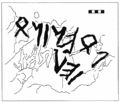VS·2
| Inscription | |
|---|---|
| Reading in transliteration: | poenino / ieu??? |
| Reading in original script: | ??? |
|
| |
| Object: | VS·2 Liddes (slab) |
| Position: | front |
| Orientation: | 330° |
| Direction of writing: | sinistroverse |
| Script: | North Italic script (Lepontic alphabet) |
| adapted to: | Latin script |
| Letter height: | 6–7 cm2.362 in <br />2.756 in <br /> |
| Number of letters: | 12 |
| Number of lines: | 2 |
| Workmanship: | carved |
| Condition: | damaged |
|
| |
| Archaeological culture: | La Tène D 2, Late Republican, Augustan [from object] |
| Date of inscription: | 55–15 BC [from object] |
|
| |
| Type: | dedicatory |
| Language: | Celtic |
| Meaning: | 'dedicated to Poeninos' |
|
| |
| Alternative sigla: | none |
|
| |
| Sources: | Aberson et al. 2021: 309–332 |
Images
Commentary
First published in Andenmatten & Paccolat 2012: 91.
Images in Andenmatten & Paccolat 2012: 91, fig. 19 (photo) and 20 (drawing).
Inscribed in two sinistroverse lines (length of line 1 32 cm) with an iron tool on the vertical face of the stone; the scratches are today 5–12 mm wide and 0.5–3 mm deep. See Aberson et al. 2021 for a detailed description of the inscription, its application, discovery and documentation. The reading of line 1 and of the first three letters of line 2 is unproblematic. The fourth letter in line 2 is Latin rho ![]() in an angular ductus in which it also appears in the Latin-Venetic mixed inscription UD·1 and in the para-script TI·6, followed by another epsilon and upsilon. The form of omicron twice in line 1 stands out as atypical for the Lepontic alphabet without being a feature of Latinisation; the clearly and deliberately carved "feet" can hardly be compared with sloppily prolonged half-circles in graffiti (pace Aberson et al. 2021: 313). The comparison of the shapes of omicron and rho with those of Runic ⟨o⟩ and ⟨r⟩ suggests itself, but leads no further. The inscription's authenticity was originally called into question due to its conspicuous mix of Celtic and Latin (and Runic) features and of well-known lexical elements with unclear grammatical structure.
in an angular ductus in which it also appears in the Latin-Venetic mixed inscription UD·1 and in the para-script TI·6, followed by another epsilon and upsilon. The form of omicron twice in line 1 stands out as atypical for the Lepontic alphabet without being a feature of Latinisation; the clearly and deliberately carved "feet" can hardly be compared with sloppily prolonged half-circles in graffiti (pace Aberson et al. 2021: 313). The comparison of the shapes of omicron and rho with those of Runic ⟨o⟩ and ⟨r⟩ suggests itself, but leads no further. The inscription's authenticity was originally called into question due to its conspicuous mix of Celtic and Latin (and Runic) features and of well-known lexical elements with unclear grammatical structure.
The inscription is one of the few dedications in the corpus.
Bibliography
| Aberson et al. 2021 | Michel Aberson, Romain Andenmatten, Stefania Casini, Angelo E. Fossati, Rudolf Wachter, "Entre Celtes et Romains : la dédicace à Poeninos du Mur (dit) d'Hannibal", in: María José Estarán Tolosa, Emmanuel Dupraz, Michel Aberson (eds), Des mots pour les dieux. Dédicaces cultuelles dans les langues indigènes de la méditerranée occidentale, Berne: Peter Lang 2021, 309–332. |
|---|---|
| Andenmatten & Paccolat 2012 | Romain Andenmatten, Olivier Paccolat, "Le mur (dit) d'Hannibal: une site de haute montagne de la fin de l'âge de Fer. Avec les contributions d'Olivier Mermod, Angela Schlumbaum et Jacqueline Studer", Jahrbuch Archäologie Schweiz 95 (2012), 77-95. |
| Appolonia et al. 2008 | Lorenzo Appolonia, François Wiblé, Patrizia Framarin (eds), Alpis Poenina, Grand Saint-Bernard. Une voie à travers l’Europe. Séminaire de clôture, 11/12 avril 2008, Fort de Bard (Vallée d’Aoste), Aoste: 2008. |
| Casini et al. 2008 | Stefania Casini, Angelo Fossati, Filippo Motta, "Incisioni protostoriche e iscrizioni leponzie su roccia alle sorgenti del Brembo (Val Camisana di Carona, Bergamo). Note preliminari", Notizie Archeologice Bergomensi 16 (2008), 75–101. |
| Casini et al. 2013 | Stefania Casini, Angelo E. Fossati, Filippo Motta, "L'iscrizione in alfabeto di Lugano al Mur d'Hannibal (Liddes, Valais)", Notizie Archeologiche Bergomensi 21 (2013), 157–165. |
| Eska & Eska 2022 | Joseph F. Eska, Charlene M. Eska, "Epigraphic and linguistic observations on the inscription at the so-called Mur d'Hannibal (Liddes, Valais)", Zeitschrift für celtische Philologie 69/1 (2022), 159–182. |

